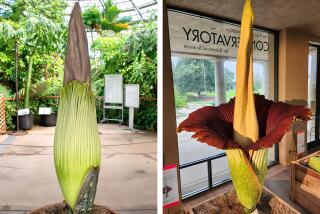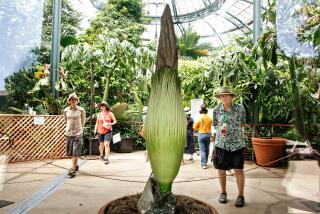Voodoo Lily Is as Eerie as Its Name
Voodoo lily is a most unusual plant, beginning with the fact that it flowers reliably in midwinter without even being planted in soil. Set the tuber, which is about the size of a softball, in a saucer just to keep it from tipping over.
About this time of year, a chocolate-brown, pointed shoot emerges. The shoot grows measurably each day, and when about 5 feet tall, an inverted, plum-purple skirt unfurls. The flower is more eerie than beautiful, the eeriness intensified by the flower’s being perched atop a 5-foot stalk growing from the top of a naked tuber.
Now for a downside to this plant: The flower’s aroma can make a whole room reek like an abandoned fish market.
At this point, you might want to seal the flower in a plastic bag and let it wait out spring in your basement.
The odor of these plants attracts carrion insects, which pollinate the flowers in their native habitats.
Voodoo lily’s show is not over when the flower finally wilts. Each year after flowering, the plant needs to grow leaves to feed the tuber for another winter show. At this point, the tubers do need soil.
Soon after being planted in warm soil in spring, a stalk emerges, this time pale olive-green with dark-brown splotches. When the snakelike stalk reaches a couple of feet in height, a single leaf unfurls, then divides and spreads like three radii of a circle. At this stage, the plant is quite attractive, but still eerie.
At the end of summer, the tuber must be dug up for storage. As a tropical plant, it cannot tolerate temperatures below 50 degrees, even when dormant.
Close relatives of voodoo lily have made headlines in their day.
In 1932, the New York Botanical Garden received a 60-pound tuber of one from Sumatra. After growing only leaves for a few years, a flower finally emerged, this one 4 1/2 feet across and capping a shoot more than 8 feet high. Newspaper clippings showed the great botanist, Hugo de Vries, perched on a stepladder, peering into the giant flower.
Voodoo lily is not likely to be found among the bins of gladiolus, begonia, and dahlia bulbs at garden-supply stores in spring.
It does periodically turn up in mail-order catalogs, sometimes under such names as Snake Palm or Devil’s Tongue.






